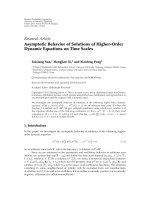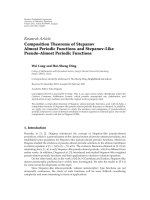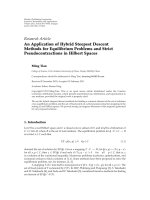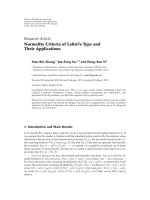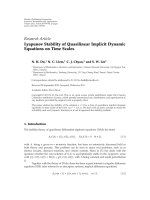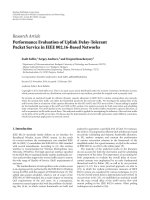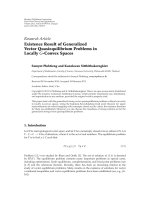Báo cáo hóa học: " Research Article Asymptotic Behavior of a Periodic Diffusion System" pot
Bạn đang xem bản rút gọn của tài liệu. Xem và tải ngay bản đầy đủ của tài liệu tại đây (501.79 KB, 11 trang )
Hindawi Publishing Corporation
Journal of Inequalities and Applications
Volume 2010, Article ID 764703, 11 pages
doi:10.1155/2010/764703
Research Article
Asymptotic Behavior of a Periodic Diffusion System
Songsong Li
1, 2
and Xiaofeng Hui
1
1
School of Management, Harbin Institute of Technology, Harbin 150001, China
2
School of Finance and Economics Management, Harbin University, Harbin 150086, China
Correspondence should be addressed to Songsong Li,
Received 26 June 2010; Accepted 25 August 2010
Academic Editor: P. J. Y. Wong
Copyright q 2010 S. Li and X. Hui. This is an open access article distributed under the Creative
Commons Attribution License, which permits unrestricted use, distribution, and reproduction in
any medium, provided the original work is properly cited.
We study the asymptotic behavior of the nonnegative solutions of a periodic reaction diffusion
system. By obtaining a priori upper bound of the nonnegative periodic solutions of the
corresponding periodic diffusion system, we establish the existence of the maximum periodic
solution and the asymptotic boundedness of the nonnegative solutions of the initial boundary
value problem.
1. Introduction
In this paper, we consider the following periodic reaction diffusion system:
∂u
∂t
Δu
m
1
b
1
u
α
1
v
β
1
,
x, t
∈ Ω × R
, 1.1
∂v
∂t
Δu
m
2
b
2
u
α
2
v
β
2
,
x, t
∈ Ω × R
, 1.2
with initial boundary conditions
u
x, t
v
x, t
0,
x, t
∈ ∂Ω × R
, 1.3
u
x, 0
u
0
x
,v
x, 0
v
0
x
,x∈ Ω, 1.4
where m
1
, m
2
> 1, α
1
, α
2
, β
1
, β
2
≥ 1, Ω ⊂ R
n
is a bounded domain with a smooth boundary
∂Ω, b
1
b
1
x, t and b
2
b
2
x, t are nonnegative continuous functions and of T-periodic
T>0 with respect to t,andu
0
and v
0
are nonnegative bounded smooth functions.
2 Journal of Inequalities and Applications
In dynamics of biological groups 1, 2, the system 1.1-1.2 wasusedtodescribe
the interaction of two biological groups without self-limiting, where the diffusion terms
reflect that the speed of the diffusion is slow. In addition, the system 1.1-1.2 can also
be used to describe diffusion processes of heat and burning in mixed media with nonlinear
conductivity and volume release, where the functions u, v can be treated as temperatures of
interacting components in the combustible mixture 3.
For case of m
1
m
2
1, we get the classical reaction diffusion system of Fujita type
∂u
∂t
Δu u
α
1
v
β
1
,
∂v
∂t
Δv u
α
2
v
β
2
.
1.5
This type reaction diffusion system 1.5 models such as heat propagations in a two-
component combustible mixture 4, chemical processes 5, and interaction of two biological
groups without self-limiting 6, 7. The problem about system 1.5 includes global existence
and global existence numbers, blow-up, blow-up rates, blow-up sets, and uniqueness of weak
solutions see 8–10 and references therein.
In this paper, we will work on the diffusion system 1.1-1.2; for results about single
equation, see 11–16 and so on. In the past two decades, the system 1.1-1.2 has been
deeply investigated by many authors, and there have been much excellent works on the
existence, uniqueness, regularity and some other qualitative properties of the weak solutions
of the initial boundary value problem see 17–22 and references therein. Maddalena 20
especially, established the existence and uniqueness of the solutions of the initial boundary
value problem 1.1–1.4, and Wang 22 established the existence of the nonnegative
nontrivial periodic solutions of the periodic boundary value problem 1.1
–1.3 when m
i
> 1,
α
i
,β
i
≥ 1, and α
i
/m
1
β
i
/m
2
< 1, i 1, 2.
Our work is to consider the existence and attractivity of the maximal periodic solution
of the problem 1.1–1.3. It should be remarked that our work is not a simple work. The
main reason is that the degeneracy of 1.1, 1.2 makes the work of energy estimates more
complicated. Since the equations have periodic sources, it is of no meaning to consider the
steady state. So, we have to seek a new approach to describe the asymptotic behavior of
the nonnegative solutions of the initial boundary value problem. Our idea is to consider
all the nonnegative periodic solutions. We fist establish some important estimations on the
nonnegative periodic solutions. Then by the De Giorgi iteration technique, we provide a
priori estimate of the nonnegative periodic solutions from the upper bound according to the
maximum norm. These estimates are crucial for the proof of the existence of the maximal
periodic solution and the asymptotic boundedness of the nonnegative solutions of the initial
boundary value problem.
This paper is organized as follows. In Section 2, we introduce some necessary
preliminaries and the statement of our main results. In Section 3, we give the proof of our
main results.
2. Preliminary
In this section, as preliminaries, we present the definition of weak solutions and some useful
principles. Since 1.1 and 1.2 are degenerated whenever u v 0, we focus our main
efforts on the discussion of weak solutions.
Journal of Inequalities and Applications 3
Definition 2.1. A vector-valued function u, v is called to be a weak supsolution to the
problem 1.1–1.4 in Q
τ
Ω× 0,τ with τ>0if|∇u
m
1
|, |∇v
m
2
|∈L
2
Q
τ
, and for any
nonnegative function ϕ ∈ C
1
Q
τ
with ϕ|
∂Ω×0,τ
0 one has
Ω
u
x, τ
ϕ
x, τ
dx −
Ω
u
0
x
ϕ
x, 0
dx −
Q
τ
u
∂ϕ
∂t
dxdt
Q
τ
∇u
m
1
∇ϕdxdt≥
Q
τ
b
1
u
α
1
v
β
1
ϕdxdt,
Ω
v
x, τ
ϕ
x, τ
dx −
Ω
v
0
x
ϕ
x, 0
dx −
Q
τ
v
∂ϕ
∂t
dx dt
Q
τ
∇v
m
2
∇ϕdxdt≥
Q
τ
b
2
u
α
2
v
β
2
ϕdxdt,
u
x, t
≥ 0,v
x, t
≥ 0,
x, t
∈ ∂Ω ×
0,τ
,
u
x, 0
≥ u
0
x
,v
x, 0
≥ v
0
x
,x∈ Ω.
2.1
Replacing “≥”by“≤” in the above inequalities follows the definition of a weak
subsolution. Furthermore, if u, v is a weak supersolution as well as a weak subsolution,
then we call it a weak solution of the problem 1.1–1.4.
Definition 2.2. A vector-valued function u, v is said to be a T-periodic solution of the
problem 1.1–1.3 if it is a solution such that
u
·, 0
u
·,T
,v
·, 0
v
·,T
a.einΩ. 2.2
A vector-valued function
u, v is said to be a T-periodic supersolution of the problem 1.1–
1.3 if it is a supersolution such that
u
·, 0
≥ u
·,T
, v
·, 0
≥ v
·,T
a.einΩ. 2.3
A vector-valued function u
,v is said to be a T-periodic subsolution of the problem 1.1–
1.3 if it is a subsolution such that
u
·, 0
≤ u
·,T
,v
·, 0
≤ v
·,T
a.einΩ. 2.4
A pair of supersolution
u, v and subsolution u,v are called to be ordered if
u ≥ u, v ≥ v a.e. in Q
T
Ω ×
0,T
.
2.5
Several properties of solutions of problem 1.1–1.4 are needed in this paper.
Lemma 2.3 see 17. If α
i
≥ 1, β
i
≥ 1, α
i
/m
1
β
i
/m
2
< 1 with |Ω| <M
0
and M
0
is a
constant depending on m
i
,α
i
,β
i
, i = 1, 2, then there exist global weak solutions to 1.1–1.4.
4 Journal of Inequalities and Applications
Lemma 2.4 see 20. Letting u
,v be a subsolution of the problem 1.1–1.4 with the initial
value u
0
,v
0
, and letting u, v be a supsolution of the problem 1.1–1.4 with the initial value
u
0
, v
0
,thenu ≤ u, v ≤ v a.e. in Q
T
if u
0
≤ u
0
, v
0
≤ v
0
a.e. in Ω.
Lemma 2.5 regularity 23. Let ux, t be a weak solution of
∂u
∂t
Δu
m
f
x, t
,m>1,
2.6
subject to the homogeneous Dirichlet condition 1.3.Iff ∈ L
∞
Q
T
, then there exist positive
constants K and β ∈ 0, 1 depending only upon τ ∈ 0,T and f
∞
such that for any
x
1
,t
1
, x
2
,t
2
∈ Ω × τ, T, one has
|
u
x
1
,t
1
− u
x
2
,t
2
|
≤ K
|
x
1
− x
2
|
β
|
t
1
− t
2
|
β/2
. 2.7
The main result of this paper is the following theorem.
Theorem 2.6. If m
i
> 1, α
i
≥ 1, β
i
≥ 1, and α
i
/m
1
β
i
/m
2
< 1 with |Ω| <M
0
and M
0
is
a constant depending on m
i
,α
i
,β
i
, i 1, 2, then problem 1.1–1.3 has a maximal periodic solution
U, V which is positive in Ω
. Moreover, if u, v is the solution of the initial boundary value problem
1.1–1.4 with nonnegative initial value u
0
,v
0
, then for any ε>0,thereexistst
1
depending on u
0
and ε, t
2
depending on v
0
and ε, such that
0 ≤ u ≤ U ε, for x ∈ Ω,t≥ t
1
,
0 ≤ v ≤ V ε, for x ∈ Ω,t≥ t
2
.
2.8
3. The Main Results
In this section, we first show some important estimates on the solutions of the periodic
problem 1.1–1.3. Then, by the De Giorgi iteration technique, we establish the a prior
upper bound of periodic solutions of 1.1–1.3, which is used to show the existence of the
maximal periodic solution of 1.1–1.3 and its attractivity with respective to the nonnegative
solutions of the initial boundary value problem 1.1–1.4.
Lemma 3.1. Let u, v be nonnegative solution of 1.1–1.3.Ifα
i
≥ 1,β
i
≥ 1, α
i
/m
1
β
i
/m
2
<
1 with |Ω| <M
0
and M
0
is a constant depending on m
i
,α
i
,β
i
, i 1, 2, then there exists positive
constants r and s large enough such that
α
2
m
2
− β
2
<
m
1
r − 1
m
2
s − 1
<
m
1
− α
1
β
1
,
3.1
u
L
r
Q
T
≤ C,
v
L
s
Q
T
≤ C,
3.2
where C>0 is a positive constant depending on m
1
, m
2
, α
1
, α
2
, β
1
, β
2
, r, s, and |Ω|.
Journal of Inequalities and Applications 5
Proof. For r>1, multiplying 1.1 by u
r−1
and integrating over Q
T
, by the periodic boundary
value condition, we have
4
r − 1
m
1
m
1
r − 1
2
Ω
∇u
m
1
r−1/2
2
dx dt
Q
T
b
1
x, t
u
α
1
r−1
v
β
1
dx dt,
3.3
that is,
Ω
∇u
m
1
r−1/2
2
dx dt ≤
C
b
m
1
r − 1
2
4
r − 1
m
1
Q
T
u
α
1
r−1
v
β
1
dx dt,
3.4
where C
b
b
1
x, t
Q
T
. By the Poincar
´
e inequality, we have
Ω
u
m
1
r−1
ε
dx ≤ C
Ω
∇u
m
1
r−1/2
ε
2
dx,
3.5
where C is a constant depending only on |Ω| and N.Noticethatα
1
/m
1
β
1
/m
2
< 1
implies α
1
<m
1
. Furthermore, we have α
1
r − 1 <m
1
r − 1. Then, by Young’s inequality,
we obtain
u
α
1
r−1
v
β
1
≤
1
2
r − 1
m
1
CC
b
2
m
1
r − 1
2
u
m
1
r−1
C
1
v
β
1
m
1
r−1/m
1
−α
1
,
3.6
where C
1
is the constant of Young’s inequality. Then, from 3.4, we have
Q
T
u
m
1
r−1
dx dt ≤
1
2
Q
T
u
m
1
r−1
dx dt C
1
Q
T
v
β
1
m
1
r−1/m
1
−α
1
dx dt,
3.7
that is,
Q
T
u
m
1
r−1
dx dt ≤ C
1
Q
T
v
β
1
m
1
r−1/m
1
−α
1
dx dt.
3.8
Similarly, we get an estimate for v
s
with s>1, that is,
Q
T
v
m
2
s−1
dx dt ≤ C
2
Q
T
u
α
2
m
2
s−1/m
2
−β
2
dx dt.
3.9
Hence,
Q
T
u
m
1
r−1
dx dt
Q
T
v
m
2
s−1
dx dt
≤ C
1
Q
T
v
β
1
m
1
r−1/m
1
−α
1
dx dt C
2
Q
T
u
α
2
m
2
s−1/m
2
−β
2
dx dt.
3.10
6 Journal of Inequalities and Applications
Notice that, α
i
/m
1
β
i
/m
2
< 1, i 1, 2, implies α
2
β
1
< m
1
− α
1
m
2
− β
2
. Then there exist
r ≥ max{2m
1
α
1
, 2α
2
} and s ≥ max{2m
2
β
2
, 2β
1
} such that
β
1
m
1
− α
1
<
m
2
s − 1
m
1
r − 1
<
m
2
− β
2
α
2
.
3.11
By Young’s inequality, we have
Q
T
u
α
2
m
2
s−1/m
2
−β
2
dx dt ≤
1
2C
2
Q
T
u
m
1
r−1
dx dt C
|
Q
T
|
,
Q
T
v
β
1
m
1
r−1/m
1
−α
1
dx dt ≤
1
2C
1
Q
T
v
m
2
s−1
dx dt C
|
Q
T
|
.
3.12
Together with 3.10,weobtain
Q
T
u
m
1
r−1
dx dt
Q
T
v
m
2
s−1
dx dt ≤ C.
3.13
Thus, we prove the inequality 3.2.
Lemma 3.2. Let u, v be nonnegative solution of 1.1–1.3.Ifα
i
≥ 1,β
i
≥ 1, α
i
/m
1
β
i
/m
2
<
1 with |Ω| <M
0
and M
0
is a constant depending on m
i
,α
i
,β
i
, i 1, 2, then one has
Q
T
|
∇u
m
1
|
2
dx dt ≤ C,
Q
T
|
∇v
m
2
|
2
dx dt ≤ C,
3.14
where C>0 is a positive constant depending on m
1
, m
2
, α
1
, α
2
, β
1
, β
2
, r, s, and |Ω|.
Proof. Multiplying 1.1 by u
m
1
and integrating over Q
T
,byH
¨
older’s equality, we have
Q
T
|
∇u
m
1
|
2
dx dt ≤
Q
T
u
α
1
m
1
v
β
1
dx dt
≤
Q
T
u
2α
1
m
1
dx dt
1/2
Q
T
v
2β
1
dx dt
1/2
.
3.15
Taking r ≥ max{2α
1
m
1
, 2β
2
}, s ≥ max{2β
2
m
2
, 2α
1
},byLemma 3.1, we can obtain the
first inequality in 3.14. The same is true for the second inequality in 3.14.
Before we show the uniform super bound of maximum modulus, we first introduce a
lemma as follows see 24 .
Lemma 3.3. Suppose that a sequence y
h
,h 0, 1, 2, of nonnegative numbers satisfies the recursion
relation
y
h1
≤ cb
h
y
1ε
h
,h 0, 1, ,
3.16
Journal of Inequalities and Applications 7
with some positive constants c, ε and b ≥ 1. Then,
y
h
≤ c
1ε
h
−1/ε
b
1ε
h
−1/ε
2
−h/ε
y
1ε
h
0
.
3.17
In particular, if
y
0
≤ θ c
−1/ε
b
−1/ε
2
,b>1,
3.18
then,
y
h
≤ θb
−h/ε
,
3.19
and consequently y
h
→ 0 for h →∞.
Lemma 3.4. Let u, v be a solution of 1.1–1.3.Ifα
i
≥ 1,β
i
≥ 1, α
i
/m
1
β
i
/m
2
< 1 with
|Ω| <M
0
and M
0
is a constant depending on m
i
,α
i
,β
i
, i 1, 2, then there is a positive constant C
such that
u
L
∞
Q
T
≤ C,
v
L
∞
Q
T
≤ C.
3.20
Proof. Let k be a positive constant. Multiplying 1.1 by u − k
m
1
and integrating over Q
T
,we
have
1
m
1
1
Q
T
∂
∂t
u − k
m
1
1
dx dt
Q
T
∇
u − k
m
1
2
dx dt
Q
T
b
1
x, t
u
α
1
v
β
1
u − k
m
1
dx dt,
3.21
where s
max{s, 0}. Denote that μkmes{x, t ∈ Q
T
: ux, t >k}.ByLemma 3.1 with
r and s large enough and H
¨
older’s inequality, we have
1
m
1
1
Q
T
∂
∂t
u − k
m
1
1
dx dt
Q
T
∇
u − k
m
1
2
dx dt
≤ C
Q
T
u
α
1
v
β
1
ξ
dx dt
ξ
Q
T
u − k
m
1
ξ
dx dt
1/ξ
≤ C
Q
T
u − k
m
1
ξη
dx dt
1/ξη
μ
k
1−1/η1/ξ
,
3.22
8 Journal of Inequalities and Applications
where ξ,η > 1 are to be determined. Using the N irenberg-Gagliardo inequality with
Lemma 3.1, we have
Q
T
u − k
m
1
ξη
dx dt
1/ξη
≤ C
Q
T
∇
u − k
m
1
2
dx dt
θ/2
,
3.23
where
θ
1 −
1
ξη
1
N
−
1
2
1
−1
∈
0, 1
.
3.24
Substituting 3.22 and 3.23 in 3.21, we have
Q
T
∇
u − k
m
1
2
dxdt ≤ C
Q
T
∇
u − k
m
1
2
dx dt
θ/2
μk
1−1/η1/ξ
.
3.25
Setting
w
k
Q
T
∇
u − k
m
1
2
dx dt,
3.26
from 3.25 we obtain
w
k
≤ Cμk
2/2−θ1−1/η1/ξ
.
3.27
Take k
h
M2 − 2
−h
, h 0, 1, ,andM>0 is to be determined. Then, we have
k
h1
− k
h
m
1
ξη
μ
k
h1
≤
Q
T
u − k
h
m
1
ξη
dx dt ≤ Cwk
h
ξηθ/2
.
3.28
From 3.26, we have
μ
k
h1
≤ C2
hm
1
ξη
μk
h
θη−1/2−θ
Cb
h
μk
h
γ
,
3.29
where b 2
m
1
ξη
and γ η − 1ξη − 1N/2ξη N. For any constant ξ>1, take η to be a
positive constant satisfying
η>max
2,
2ξ N
ξN
− 1
,
3.30
then we have γ>1. By Lemma 3.1, we can select M large enough such that
μ
k
0
μ
M
≤ C
−1/γ−1
4
−1/γ−1
2
.
3.31
Journal of Inequalities and Applications 9
According to Lemma 3.3, we have μk
h
→ 0, as h → ∞, which implies t hat ux, t ≤ 2M in
Q
T
. The uniform estimate for vx, t
L
∞
Q
T
may be obtained by a similar method. The proof
is completed.
Let μ, ψ be the first eigenvalue and its corresponding eigenfunction to the Laplacian
operator −Δ on some domain Ω
⊃⊃ Ω with respect to homogeneous Dirichlet data. It is clear
that ψ
x
> 0 for all x ∈ Ω.
Now we give the proof of the main results of this paper.
Proof of Theorem 2.6. We first establish the existence of the maximal periodic solution
Ux, t,Vx, t of the problem 1.1–1.3. Define the Poincar
´
e mapping
T
T
1
,T
2
: C
Ω
× C
Ω
−→ C
Ω
× C
Ω
,
T
u
0
x
,v
0
x
u
x, T
,v
x, T
,
3.32
where ux, t,vx, t is the solution of the initial boundary value problem 1.1–1.4 with
initial value u
0
x,v
0
x. A similar argument as that in 22 shows that the map T is well
defined.
Let u
n
x, t,v
n
x, t be the solution of the problem 1.1–1.4 with initial value
u
0
x
,v
0
x
u
x
, v
x
K
1
ψ
1
,K
2
ψ
2
, 3.33
where K
1
,K
2
,ψ
1
, and ψ
2
are taken as those in 22. Then, by comparison principle, we have
u
n
x, T
,v
n
x, T
T
n
u
x
, v
x
,
u
n1
x, t
≤ u
n
x, t
≤
u
x
,v
n1
x, t
≤ v
n
x, t
≤
v
x
.
3.34
A standard argument shows that there exist u
∗
x,v
∗
x ∈ CΩ × CΩ and a subsequence
of {T
n
ux}, denoted by itself for simplicity, such that
u
∗
x
,v
∗
x
lim
n →∞
T
n
u
x
, v
x
.
3.35
Similar to the proof of Theorem 4.1in25, we can prove that Ux, t,Vx, t, which is the
even extension of the solution of the initial boundary value 1.1–1.4 with the initial value
u
∗
x,v
∗
x, is a periodic solution of 1.1–1.3. For any nonnegative periodic solution
ux, t,vx, t of 1.1 –1.3,byLemma 3.4, we have
u
x, t
≤ C
0
,v
x, t
≤ C
0
for
x, t
∈ Q
T
. 3.36
Taking
K
1
≥
C
0
min
x∈Ω
ϕ
1/m
1
1
x
,K
2
≥
C
0
min
x∈Ω
ϕ
1/m
2
2
x
,
3.37
10 Journal of Inequalities and Applications
to be combined with the comparison principle and u
∗
x ≥ ux, 0,v
∗
x ≥ vx, 0, then we
obtain Ux, t ≥ ux, t, V x, t ≥ vx, t, which implies that Ux, t,Vx, t is the maximal
periodic solution of 1.1–1.3.
For any given nonnegative initial value u
0
x,v
0
x,letux, t,vx, t be the
solution of the initial boundary problem 1.1–1.4,andletω
1
x, t,ω
2
x, t be the solution
of 1.1–1.4 with initial value ω
1
x, 0,ω
2
x, 0 R
1
ϕ
1
x,R
2
ϕ
2
x, where R
1
,R
2
satisfy
the same conditions as K
1
,K
2
and
R
1
≥
u
0
L
∞
min
x∈Ω
ϕ
1/m
1
1
x
,R
2
≥
v
0
L
∞
min
x∈Ω
ϕ
1/m
2
2
x
.
3.38
For any x, t ∈ Q
T
, k 0, 1, 2, , we have
u
x, t kT
≤ w
1
x, t kT
,v
x, t kT
≤ w
2
x, t kT
. 3.39
A similar argument as that in 25 shows that
ω
∗
1
x, t
,ω
∗
2
x, t
lim
k →∞
ω
1
x, t kT
, lim
k →∞
ω
2
x, t kT
, 3.40
and ω
∗
1
x, t,ω
∗
2
x, t is a nontrivial nonnegative periodic solution of 1.1–1.3. Therefore,
for any ε>0, there exists k
0
such that
u
x, t kT
≤ ω
∗
1
x, t
ε ≤ U
x, t
ε,
v
x, t kT
≤ ω
∗
2
x, t
ε ≤ V
x, t
ε,
3.41
for any k ≥ k
0
and x, t ∈ Q
T
. Taking the periodicity of ω
∗
1
x, t, ω
∗
2
x, t, Ux, t,andV x, t
into account, the proof of the theorem is completed.
References
1 H. Meinhardt, Models of Biological Pattern Formation, Academic Press, London, UK, 1982.
2 Yu. M. Romanovski
˘
ı, N. V. Stepanova, and D. S. Chernavski
˘
ı, Matematicheskaya Biofizika,Nauka,
Moscow, Russia, 1984.
3 J. Bebernes and D. Eberly, Mathematical Problems from Combustion Theory, vol. 83 of Applied
Mathematical Sciences, Springer, New York, NY, USA, 1989.
4 M. Escobedo and M. A. Herrero, “Boundedness and blow up for a semilinear reaction-diffusion
system,” Journal of Differential Equations, vol. 89, no. 1, pp. 176–202, 1991.
5 P. Glansdorff and I. Prigogine, Thermodynamic Theory of Structure, Stability and Fluctuation, Wiley-
Interscience, London, UK, 1971.
6 R. C. Cantrell, C. Cosner, and V. Hutson, “Permanence in ecological systems with spatial
heterogeneity,” Proceedings of the Royal Society of Edinburgh. A, vol. 123, no. 3, pp. 533–559, 1993.
7 H. Meinhardt, Models of Biological Pattern Formation, Academic Press, London, UK, 1982.
8 G. Caristi and E. Mitidieri, “Blow-up estimates of positive solutions of a parabolic system,” Journal of
Differential Equations, vol. 113, no. 2, pp. 265–271, 1994.
9 H. W. Chen, “Global existence and blow-up for a nonlinear reaction-diffusion system,” Journal of
Mathematical Analysis and Applications, vol. 212, no. 2, pp. 481–492, 1997.
Journal of Inequalities and Applications 11
10 S. Zheng, “Global existence and global non-existence of solutions to a reaction-diffusion system,”
Nonlinear Analysis. Theory, Methods & Applications, vol. 39, no. 3, pp. 327–340, 2000.
11 P. Hess, M. A. Pozio, and A. Tesei, “Time periodic solutions for a class of degenerate parabolic
problems,” Houston Journal of Mathematics, vol. 21, no. 2, pp. 367–394, 1995.
12 J. B. Sun, B. Y. Wu, and D. Z. Zhang, “Asymptotic behavior of solutions of a periodic diffusion
equation,” Journal of Inequalities and Applications, vol. 2010, Article ID 597569, 12 pages, 2010.
13 R. Huang, Y. Wang, and Y. Y. Ke, “Existence of non-trivial nonnegative periodic solutions for a class
of degenerate parabolic equations with nonlocal terms,” Discrete and Continuous Dynamical Systems.
Series B, vol. 5, no. 4, pp. 1005–1014, 2005.
14 J. X. Yin and Y. F. Wang, “Asymptotic behaviour of solutions for porous medium equation with
periodic absorption,” International Journal of Mathematics and Mathematical Sciences, vol. 26, no. 1, pp.
35–44, 2001.
15 J. Zhou and C. L. Mu, “Time periodic solutions of porous medium equation,” Mathematical Methods
in the Applied Sciences.
16 Y. F. Wang, J. X. Yin, and Z. Q. Wu, “Periodic solutions of porous medium equations with weakly
nonlinear sources,” Northeastern Mathematical Journal, vol. 16, no. 4, pp. 475–483, 2000.
17 P. D. Lei and S. Zheng, “Global and nonglobal weak solutions to a degenerate parabolic system,”
Journal of Mathematical Analysis and Applications, vol. 324, no. 1, pp. 177–198, 2006.
18 W. Deng, “Global existence and finite time blow up for a degenerate reaction-diffusion system,”
Nonlinear Analysis. Theory, Methods & Applications, vol. 60, no. 5, pp. 977–991, 2005.
19 V. A. Galaktionov, S. P. Kurdyumov, and A. A. Samarski
˘
ı, “A parabolic system of quasilinear
equations. I,” Differential Equations, vol. 19, no. 12, pp. 2123–2140, 1983.
20 L. Maddalena, “Existence of global solution for reaction-diffusion systems with density dependent
diffusion,” Nonlinear Analysis. Theory, Methods & Applications, vol. 8, no. 11, pp. 1383–1394, 1984.
21 V. A. Galaktionov, S. P. Kurdyumov, and A. A. Samarski
˘
ı, “A parabolic system of quasilinear
equations. II,” Diff
erential Equations, vol. 21, no. 9, pp. 1049–1062, 1985.
22 Y. F. Wan g, Periodic solutions of nonlinear diffusion equations, Doctor Thesis, Jilin University, 1997.
23 E. DiBenedetto, “Continuity of weak solutions to a general porous medium equation,” Indiana
University Mathematics Journal, vol. 32, no. 1, pp. 83–118, 1983.
24 O. Ladyzenskaja, V. Solonnikov, and N. Uraltseva, “Linear and quasilinear equations of parabolic
type,” in Translations of Mathematical Monographs, vol. 23, American Mathematical Society, Berlin,
Germany, 1968.
25 H. Amann, “Periodic solutions of semilinear parabolic equations,” in Nonlinear Analysis (Collection of
Papers in Honor of Erich H. Rothe), Cesari, Kannan, and Weinberger, Eds., pp. 1–29, Academic Press,
New York, NY, USA, 1978.
